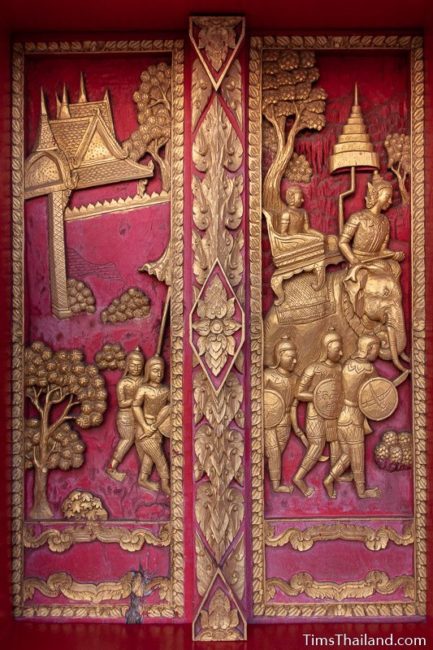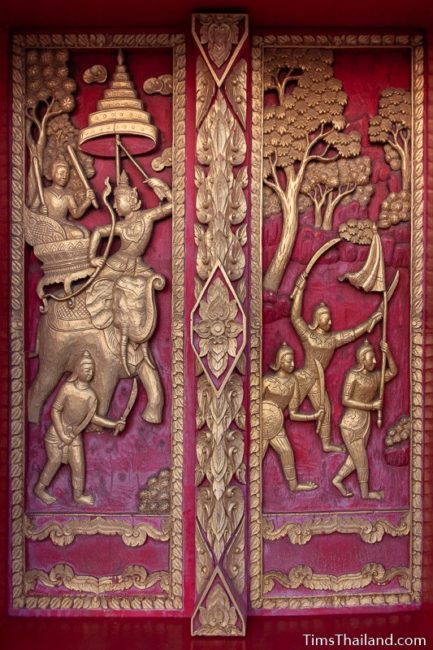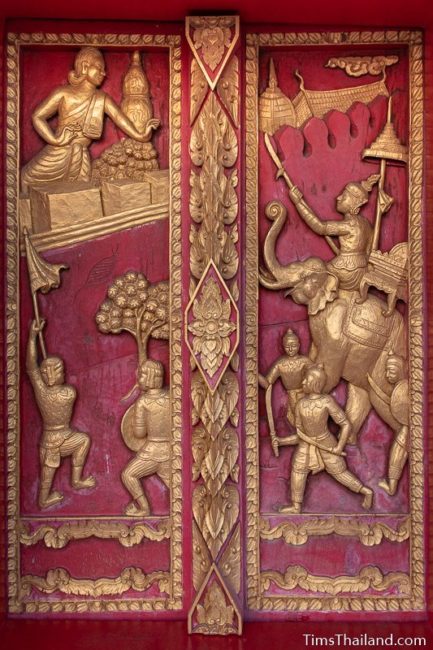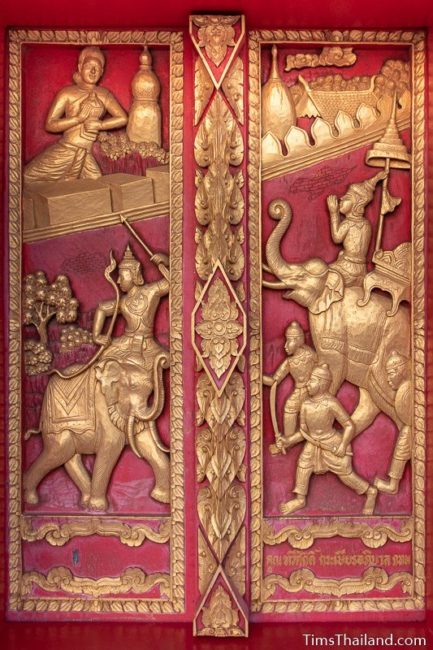อ่านภาษาไทยที่นี่ (Click here to read a Thai version.)
The carved wooden doors and window shutters on the fifth floor of Phra Mahathat Kaen Nakhon stupa at Wat Nong Wang tell some episodes (the story is far from complete) from the Buddha’s life following his enlightenment.
The story begins at the northeast corner on the east wall (in front of the stairs) and is told counterclockwise around the stupa. The first half of the Buddha’s tale is told up above on floor 6. Note that the workers installed some panels out of order, so to read the story properly, follow the numbers in parenthesis shown below.
Several of the scenes on this floor are rarely depicted, and one pair of panels (#12) is too vague to be completely sure which particular event from the Buddha’s life it tells. Even two temple artists and a knowledgeable monk I asked couldn’t be certain, but together we came to a consensus. The artist, Tawon Gonkaew, has passed away, so I couldn’t ask him.
If you want to read more about the Buddha’s life story, the two-volume The Splendour of Enlightenment: A Life of the Buddha by Phra Khantipalo, is a thorough (though not quite complete) version based entirely on texts from the Pali Canon. And for an account of the major events with scholarly commentary (in particular pointing out different, often contradictory, versions of various episodes found in the ancient texts), The Buddha: A Short Biography by John S. Strong is excellent.
— — —
(1) During the Buddha’s fifth week of meditation he sat under a banyan tree. Three of the demon god Mara’s daughters (named Pleasure, Restlessness, and Desire) danced seductively, but they were unable to disrupt the Buddha’s thoughts.
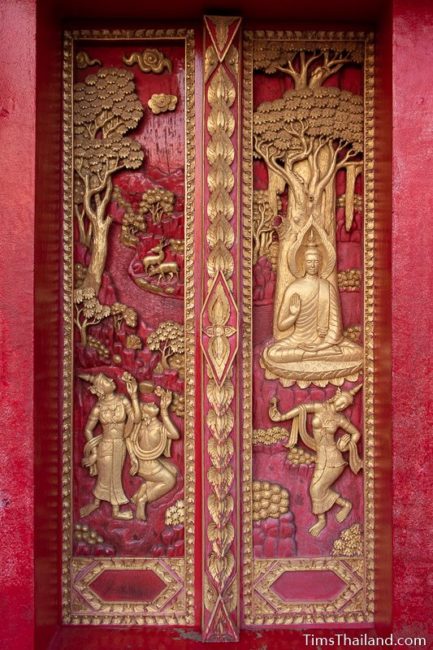
(2) During the Buddha’s final week of meditation, two travelling merchants, Tapassu and Bhalluka, passed by the Bodhi tree and, having been told by a god that there was an enlightened being there, gave the Buddha barley porridge and honey combs. But the Buddha hadn’t eaten in the past seven weeks and had no alms bowl to receive the food.
The gods of the four directions came down from heaven and offered bowls made of gold, silver, emerald, and ruby, but the Buddha rejected them as improper. So the gods brought ceramic bowls and the Buddha magically joined them into a single bowl so there would be no jealousy. Tapassu and Bhalluka donated their food and became the Buddha’s first lay followers. The Buddha wanted to give them something to venerate, so he scratched his head and eight hairs fell into their hands – legend says these hairs are now enshrined in Myanmar’s Shwedagon Pagoda.
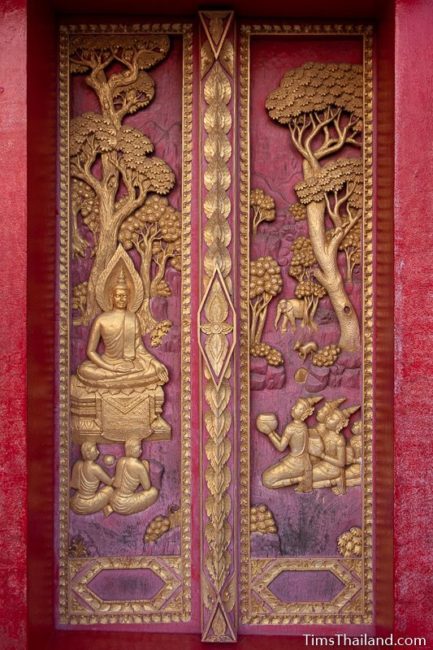
(3) The Buddha went back to the banyan tree and reflected on how difficult and profound dharma was and wondered whether there was any point in trying to teach it to others because so few people would be receptive, and even fewer would be able to grasp it. He considered living out his final years alone in the wilderness, but Brahma came down from heaven and implored him to teach and ensured him that some people would understand.
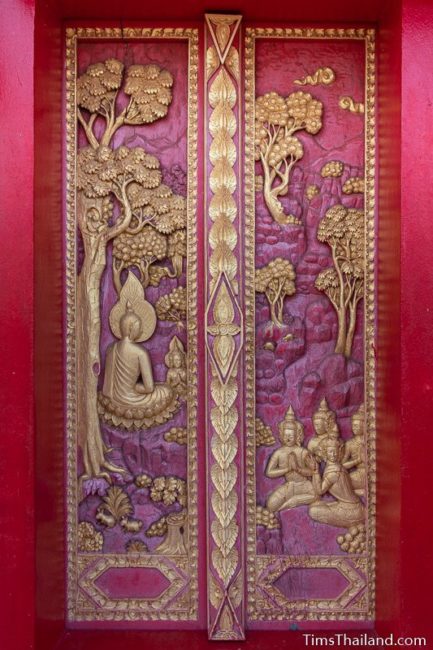
(4) The Buddha chose his five ascetic friends to be the first people to hear him explain dharma. He divined that they were staying in the Deer Park near Varanasi and walked there. At first they ignored him, but as he approached they could see his newfound nobility and they went to receive him politely. Though skeptical of his claim of enlightenment, they listened to his sermon, the Dhammacakkappavattana (“Setting the Wheel of Dharma in Motion”) Sutta, and when it was finished they ordained as his first five disciples.
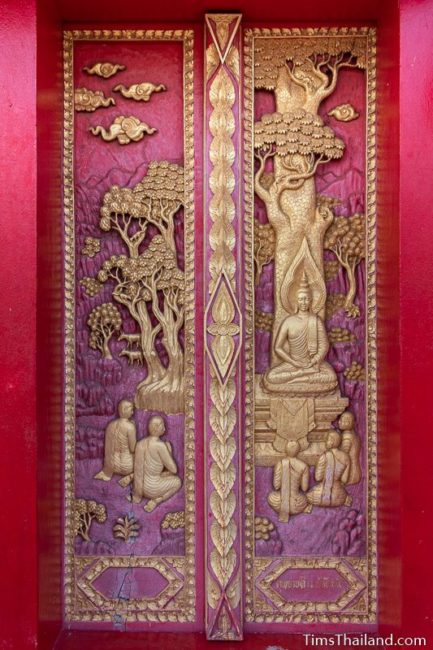
(5) After the first five monks joined the Buddha, he went out teaching dharma and quickly attracted many more followers. The next monk was Yasa, the son of a wealthy merchant, who met the Buddha near a river after he became dissatisfied with his life and fled home. Yasa’s father, mother, and former wife became the Buddha’s first lay followers. Soon after, fifty-four of Yasa’s friends also converted and joined the brotherhood.
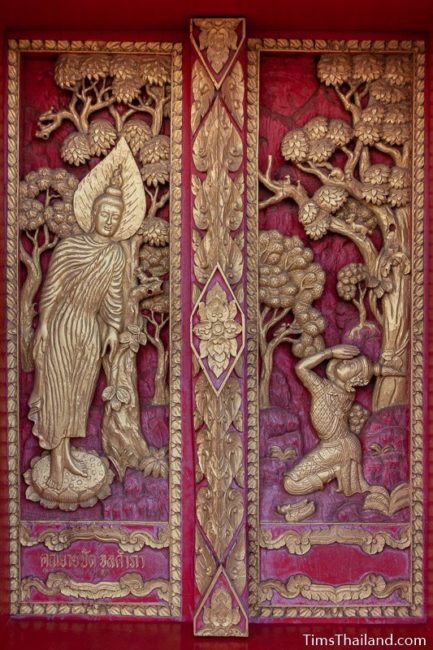
(6) Later the Buddha met Uruvela-Kassapa, an elderly, respected fire-worshipping ruesi holy man who believes he was enlightened and did not accept the Buddha’s superiority, even after watching him perform three thousand five hundred miracles; the first of which was taming a fierce naga living in Uruvela-Kassapa’s fire hall. But eventually he was swayed and he publicly announced that the Buddha was his master. His two brothers and a thousand of their followers also became monks.
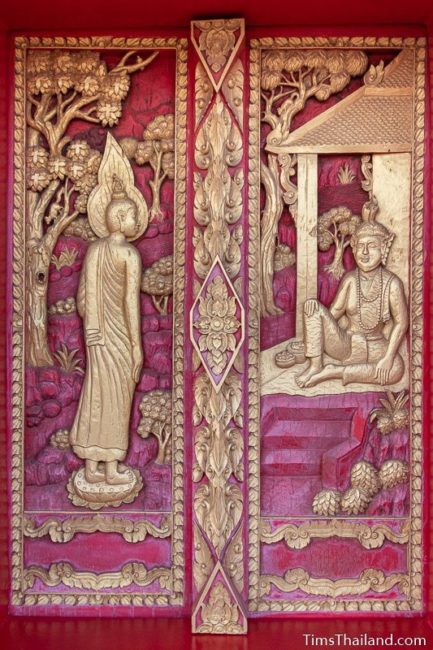
(7) Nine months after the Buddha’s enlightenment, 1,250 monks, all of whom were ordained by the Buddha himself and had reached arahantship, came to see the Buddha on a full moon day without having been invited. That evening he gave them a sermon, now known as the Ovada Patimokkha, about being virtuous and cleansing one’s mind. (Though this is minor episode only briefly mentioned in the Pali Canon, in Thailand it is celebrated during an important Buddhist holiday called Makha Bucha.)
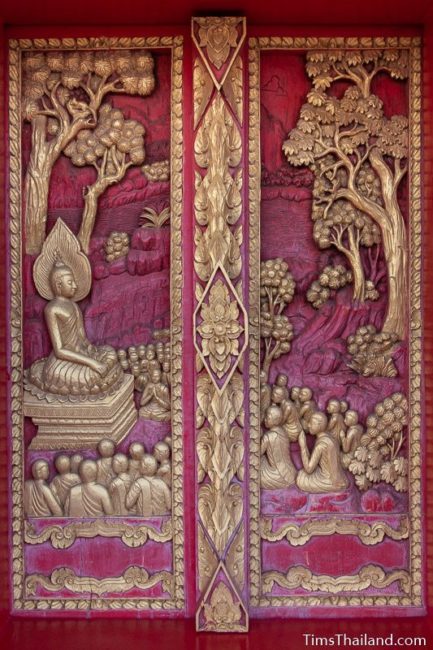
(8) When the Buddha returned to Kapilavatthu to see his family for the first time since his enlightenment, he and many monks did their morning alms round from house to house as usual. His father, King Suddhodana, was initially agitated and ashamed about this, but then finally understood that his son had reached enlightenment and this was what all previous Buddhas had done. The king was converted, though did not become a monk. Over time the Buddha preached to many people and hundreds of other male family members and servants did ordain.
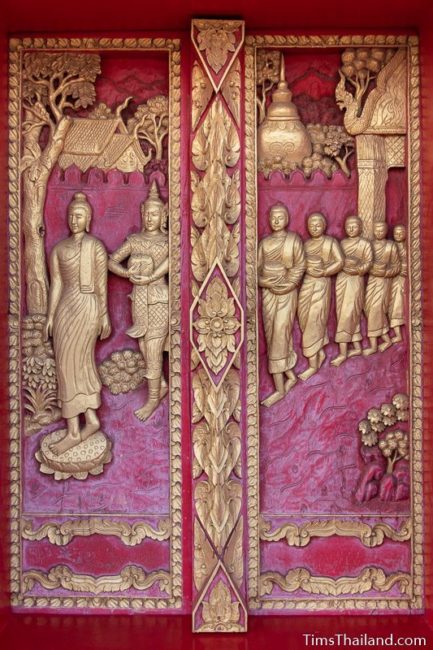
(13) At the end of the Rains Retreat, his mother was converted and understood dharma as a “stream-winner.”
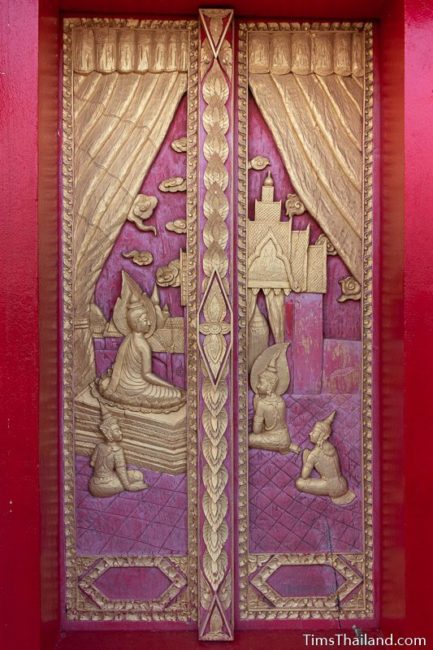
(9) The Buddha’s wife, Princess Yasodhara, did not go to see him when he returned home; she waited three days for him to come see her. When he did, in the company of the king, she grabbed him by the ankles and washed his feet with her tears and hair. (Before going to meet her, the Buddha had told his attendants to let his wife greet him in any way she wanted, no matter how inappropriate it might be.) The king praised Yasodhara’s exemplary behavior since the Buddha had abandoned her, such as only eating one meal a day and sleeping on a plank bed, in solidarity with the Buddha.
Rahula, the Buddha’s son, now about eight years old, joined his father as a novice, which angered the king and other Sakya clan elders because he was the heir to the throne. In response to his father’s agony over this, the Buddha instituted a new rule that required people to get their parent’s permission before ordaining. (Much later, after the Buddha began allowing female monks, Princess Yasodhara and Mahapajapati Gotami, the Buddha’s foster mother, also ordained.)
(25) Devadatta was the Buddha’s cousin, and initially a dedicated monk. But eventually he grew arrogant and desirous of prestige and became the Buddha’s nemesis. When Devadatta suggested that he should become the order’s new leader, the Buddha rejected this emphatically, calling Devadatta an unworthy “vile lick-spittle.” This so angered Devadatta that he decided to kill the Buddha. He hired an archer, but when he saw the Buddha, the archer froze in fear and did not shoot.
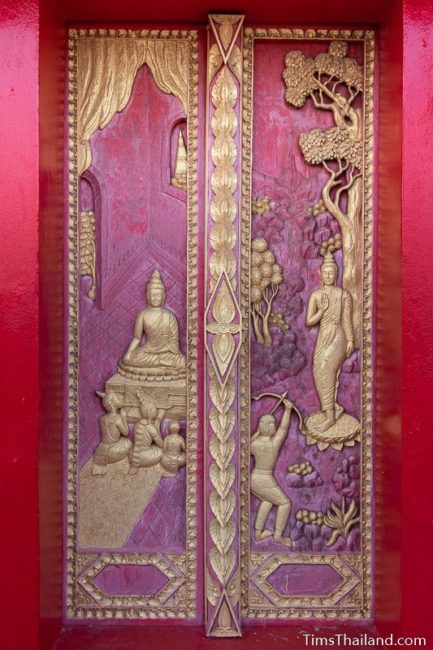
(28) For Devadatta’s third and final assassination attempt he got a fierce, man-killer elephant named Nalagiri drunk and set it down the road while the Buddha did his morning alms round. Nalagiri charged at the Buddha, but as he neared, the Buddha’s loving-kindness caused the elephant to stop and bow down before the Buddha. He cleaned the dust of the Buddha’s feet with his trunk and walked back to his stable, fierce no more.
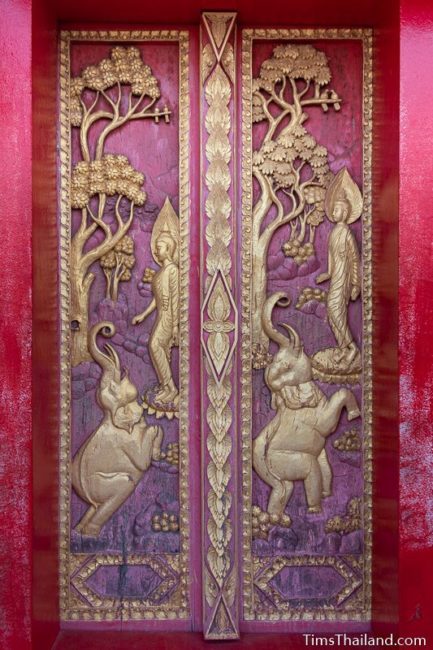
(27) On Devadatta’s second attempt on the Buddha’s life, he rolled a boulder down a hill. But before it reached the Buddha it was stopped by two outcrops and only a small splinter of the rock hit him, causing his foot to bleed.
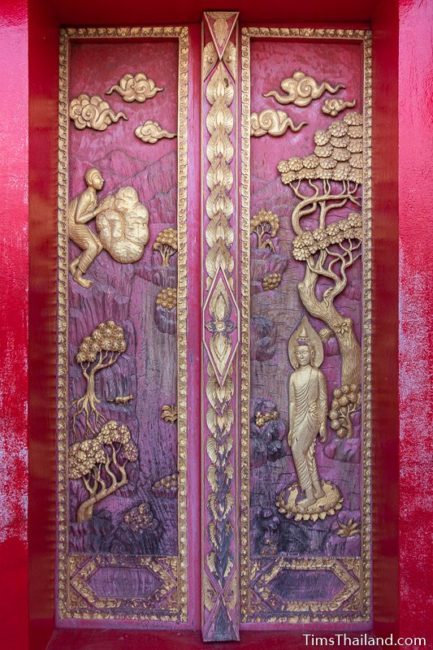
(15) The Buddha returned to earth via three flights of stairs. He descended down to Sankassa city on the middle stairs, which were made of precious gems, while on the sides, Indra and Brahma accompanied him on stairs of gold and silver respectively.
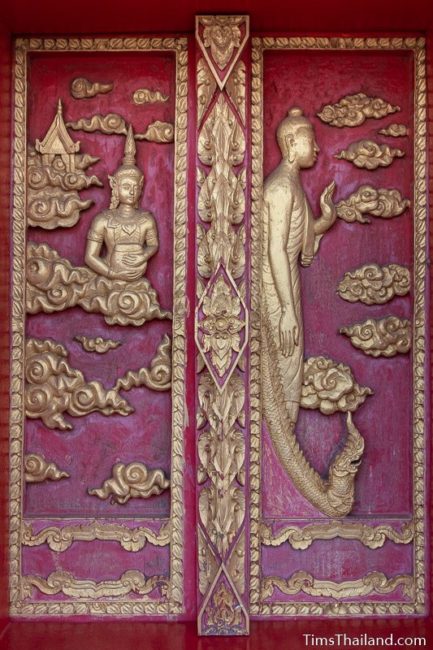
(16) When the Buddha arrived he was greeted by disciples and laity. He opened up the three realms (heaven, hell, and the earth) so people could see what two existences were waiting for them, depending on their karma.
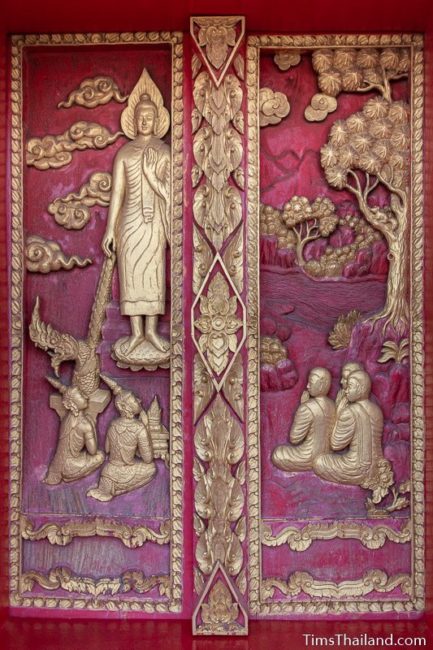
(11) In his seventh year of enlightenment, the Buddha chose to spend the Rains Retreat (phansa in Thai) preaching dharma to his mother, Maha Maya (who died a week after his birth), in Tavatimsa heaven. He took three steps to get there and arrived to a grand welcome and was seated on a throne.
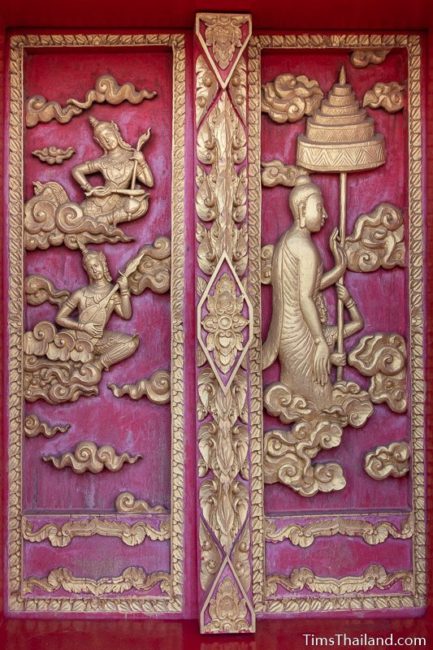
(14) When the Buddha departed, he was sent off by the grateful gods.
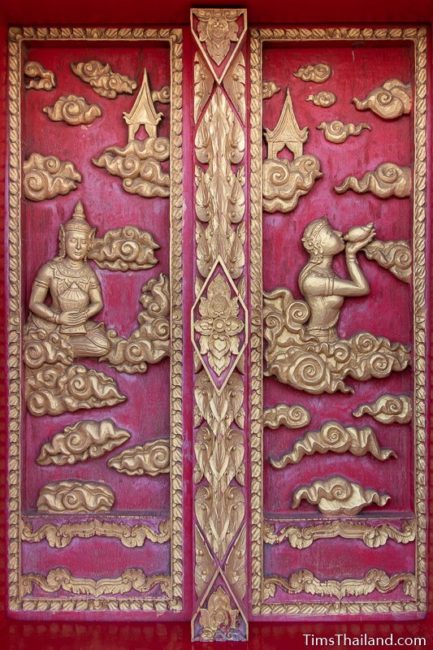
(26) The archer fell at the Buddha’s feet, confessed his intent, and asked forgiveness. After the Buddha preached dharma to him, the archer ordained as a monk. And soon after, the Buddha also converted the men Devadatta had hired to kill the original assassin in order to cover up his crime.
(29) Even after all this, the Buddha did not expel Devadatta from the brotherhood. But after he tried and failed to form a schism amongst the Buddha’s disciples, Devadatta fell very ill. He finally remembered the Buddha’s pure virtue and regretted his evil acts. He travelled to Jetavana Monastery to seek forgiveness from the Buddha, but before he arrived, the earth opened up and swallowed him into the flames of hell to suffer for an eon.
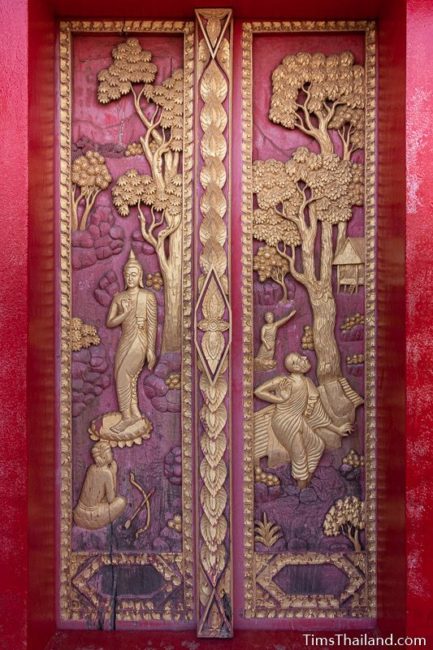
(10) Anathapindika, a wealthy merchant met the Buddha and converted, becoming one of his most devoted lay followers. He invited the Buddha to come to his city, Savatthi. Before the Buddha arrived, Anathapindika bought land in Jetavana royal park (by laying down gold pieces side by side over the total acreage he wanted) and built an opulent monastery there that, along with a nine-month dedication ceremony, cost 540 million gold coins in total. When the Buddha arrived, Anathapindika led a grand welcome ritual that included his wife and two daughters, along with one thousands maidens, bringing bowls filled to the brim with water. Jetavana Monastery would end up being the Buddha’s primary home for about half his life.
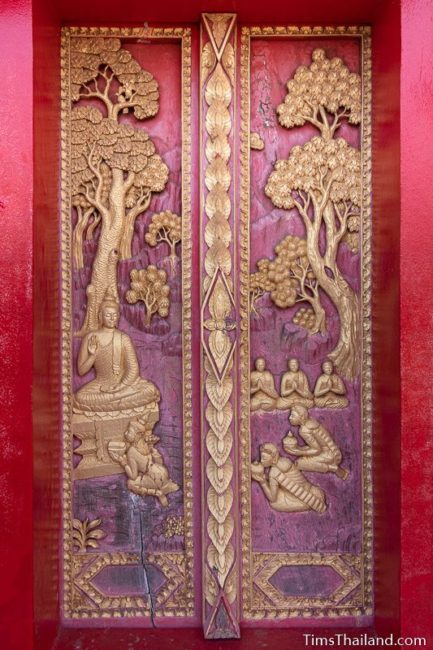
(12) Eight hundred billion gods came to hear the Buddha preach. He did so non-stop for three-months, creating a body double for when he went on his alms rounds and ate his meals.
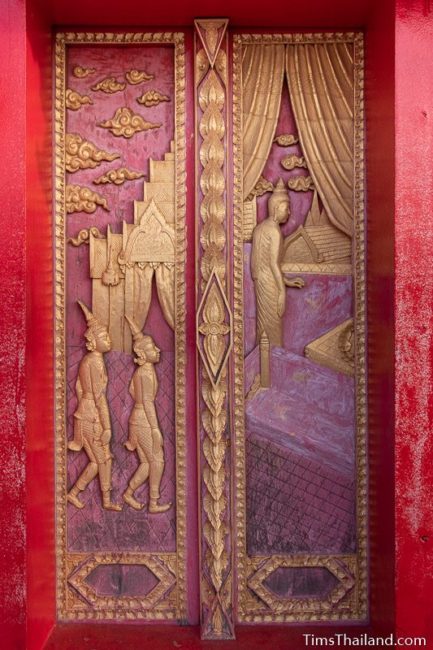
(17) After the Buddha had reached widespread fame, other religious leaders lost many followers. To get people back, a group of them hired Cinca-Manavika, a smart and beautiful woman, to destroy the Buddha’s reputation by claiming he impregnated her. She spent a lot of time around Jetavana Monastery and eventually started wrapping cloth around her stomach. As her “due date” approached, she added pieces of wood to her belly wrap and publicly denounced the Buddha for abandoning her. This angered Indra and he came to earth as a mouse and bit through the ropes holding her fake stomach up; and the wood dropped down, injuring her toes. As she fled, the ground opened up and she fell into the flames of hell.
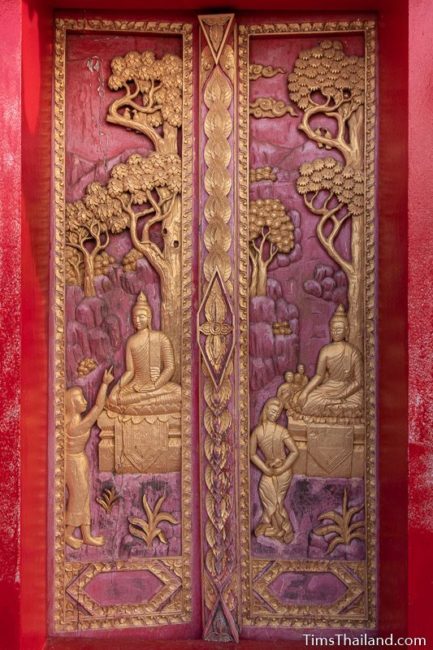
(18) A strong, wise, and devoted child named Ahimsaka was his teacher’s best student. The other students resented Ahimsaka, and through their deceit made the teacher hate him. When Ahimsaka had completed his education, his teacher demanded one thousand fingers from people’s right hands as his fee. The teacher figured Ahimsaka would not do it and then could be punished.
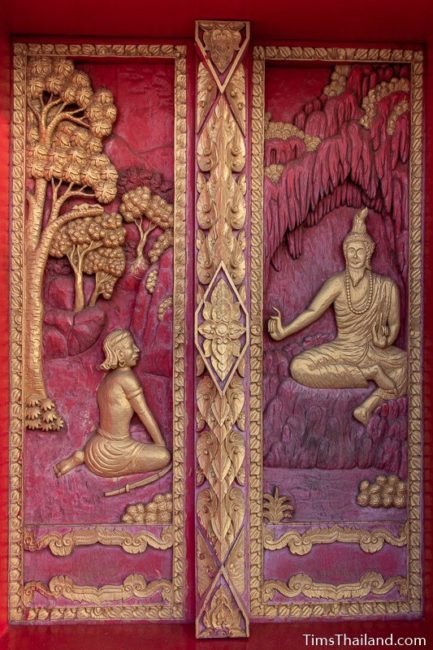
(19) But Ahimsaka was as ruthless as he was obedient, and he took a sword to a forest and attacked people to cut off their fingers, wiping out whole villages in the process. His frequent murders made him notorious and people called him Angulimala, “finger garland,” because he wore the fingers on a string around his neck.
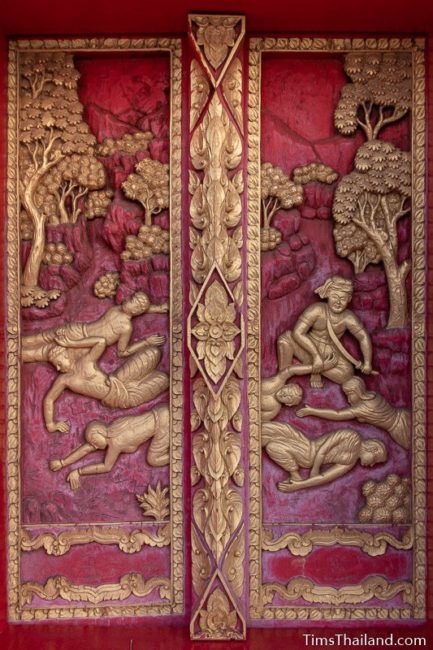
(20) When Angulimala’s mother heard of his crimes, she begged her husband to go stop him; but he no longer wanted anything to do with his evil son. So she, out of motherly love, went to the forest to do it herself.
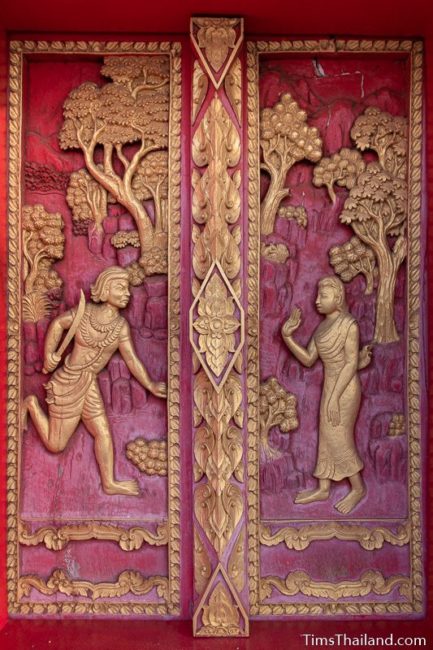
(21) The Buddha divined the danger she was in and went to save both her and Angulimala. The goatherders, farmers, and other people he passed warned him not to enter the forest, but he ignored their advice. At this point, Angulimala had acquired nine hundred ninety-nine fingers and was very eager to get the last one, so he charged toward his mother to kill her.
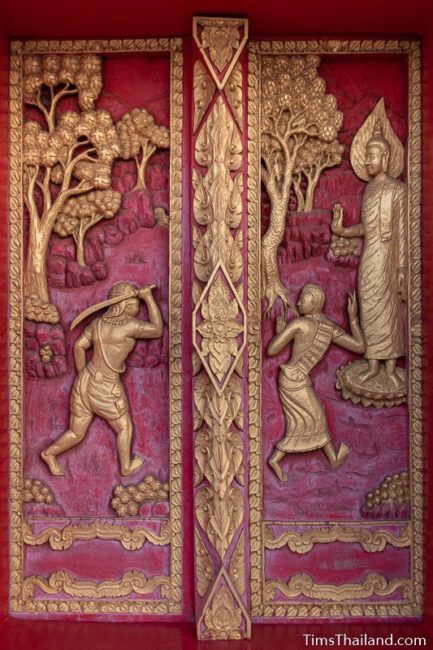
(22) When Angulimala saw the Buddha he changed his mind and ran toward him instead, glad that he no longer needed to kill his mother. The Buddha continued to walk casually, but no matter how fast he went, Angulimala, who could outrun a horse, could not catch him. So Angulimala yelled out for the Buddha to “Stand still!” “I am standing still,” the Buddha replied.
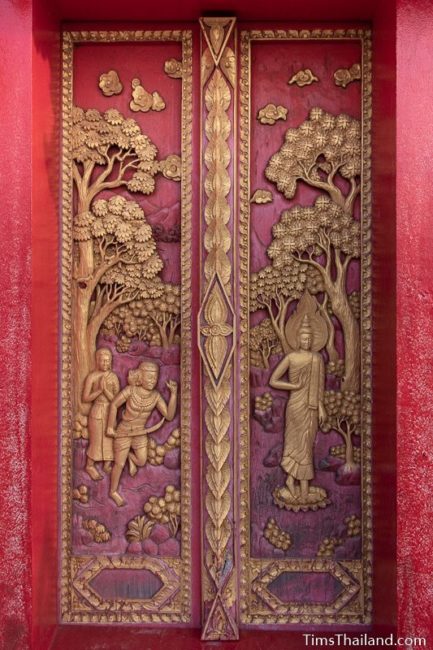
(23) Impressed by this stranger, Angulimala asked the Buddha to explain himself and he said that he stood steadfast for all living beings. This was enough wisdom for Angulimala to repent for his sins. He threw his weapons over a cliff and ordained as a monk.
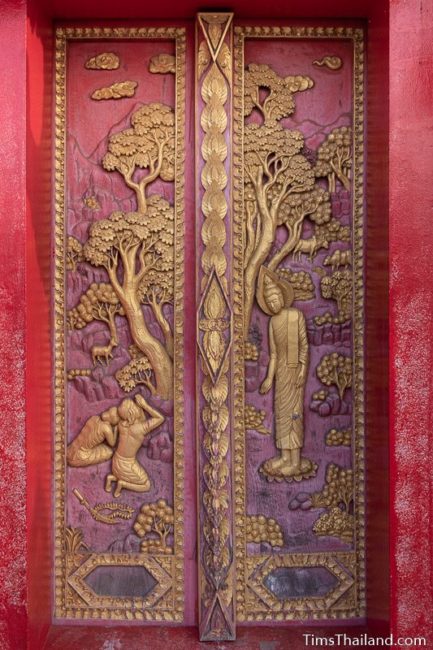
(24) The three of them walked to Jetavana Monastery, with Angulimala serving as the Buddha’s attendant. As they traveled, they met King Pasenadi who was with five hundred cavalry out to find and kill Angulimala. When the Buddha showed that he had subdued the evil, blood-thirsty killer, the king was amazed and praised the Buddha.
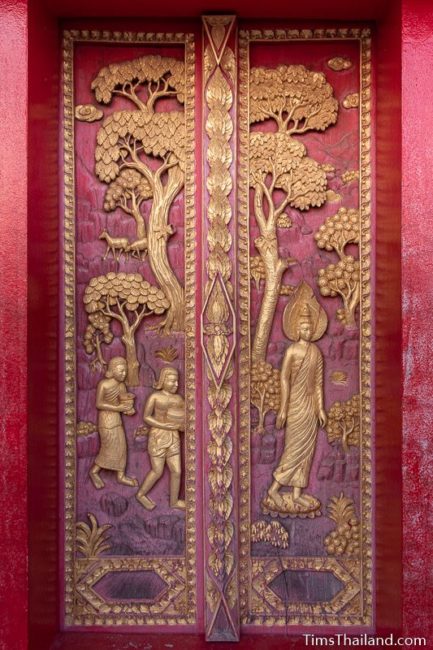
(30) When the Buddha was eighty years old, having been enlightened for forty-five years, he decided he had lived long enough and announced to his followers that he would die in three months. He spent this time traveling and on his final day he got sick from a meal (He knew the food was tainted, but ate it anyway and had the leftovers buried so nobody else would get sick.) of either pork or mushrooms (the ancient texts are unclear). He walked to the small, insignificant village of Kusinara, receiving visitors to pay their last respects and teaching his disciples. His final words were ” Listen well, my disciples. I urge you to remember that all things are impermanent. Continue striving to follow dharma.” Then through meditation, he passed into nirvana, never to be born again.
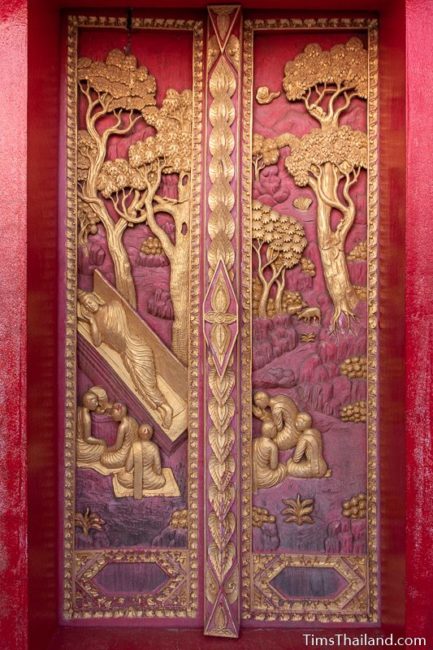
(31-34) The final four pairs of panels show what is called the War of the Relics. His corpse was burnt as per his instructions (wrapped in five hundred layers of linen and five hundred layers of cotton, placed inside two iron vessels, and laid on a pyre of perfumed wood) and the local leaders collected the remaining bone relics for veneration. Seven other kings arrived with their armies demanding a share of the relics. Initially they were refused, but for the sake of peace and harmony, the brahmin Dona divided the relics into eight equal shares and all were enshrined in stupas. Two more stupas were built for the ashes from the pyre and the urn that initially held the relics.
